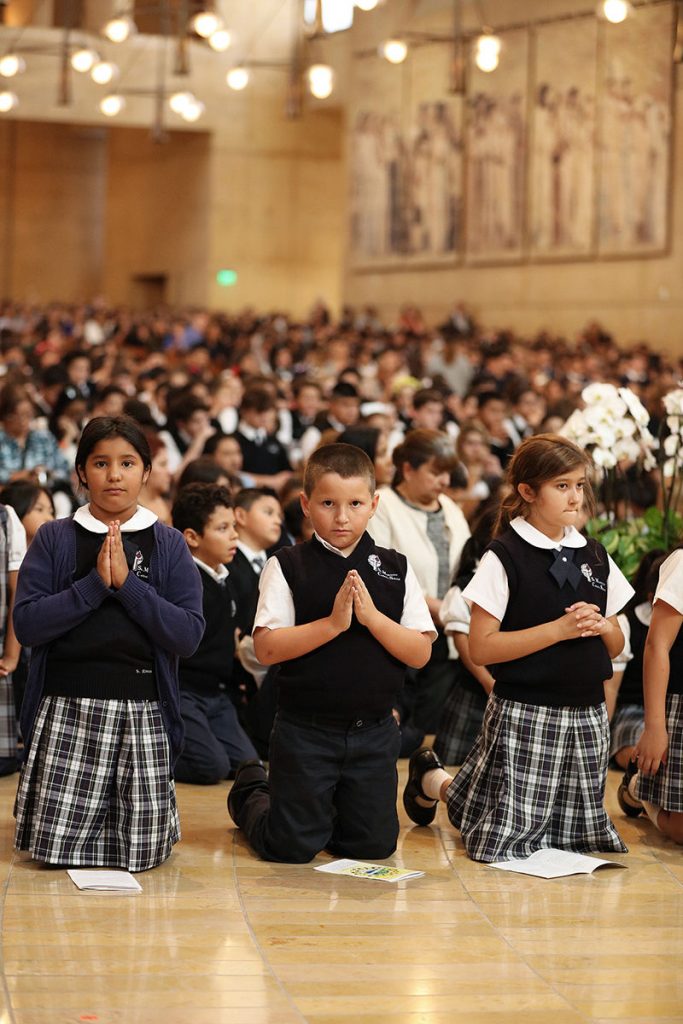Ask Kevin Baxter what he thinks about the current state of Catholic schools and the response you hear is likely to contain the words “hopeful” and “optimistic.”
Baxter is senior director and superintendent of Catholic schools for the Archdiocese of Los Angeles, and is also newly appointed to the board of the National Catholic Educational Association (NCEA). He recently returned from the NCEA’s annual Catholic Leadership Summit filled with a sense of hopeful optimism about the state of Catholic schools.
He notes that Catholic school news has been tough in some parts of the country, with areas in the Northeast and in the Midwest really struggling, but believes that overall enrollment growth could be led by areas of burgeoning Catholic populations, such as in California, Arizona and Texas.
Catholic school enrollment has fallen to its lowest point since the 1920s, according to Baxter, with under two million students enrolled nationwide. That is down from a peak of about 5.5 million students in the mid-1960s. “We’d love to see that number climb over 2 million and begin to tick in the other direction,” said Baxter.
“We’ve got a lot of Catholics here, and that is one of the reasons why we are very optimistic, both within the state of California and within the Archdiocese of Los Angeles, that we’ve got potential for growth,” Baxter said.
Baxter is optimistic that the quality Catholic schools produce can drive enrollment. He believes it comes down to two core areas: Catholic identity/faith formation and academic excellence.
He noted the importance of strong faith formation of students, but also in ensuring that teachers and principals are fully formed in the faith and that Catholic identity is very strong at the schools. “We feel that if that’s present, that’s a huge asset for the school,” he said.
Baxter stated that while Catholic schools have historically prided themselves on academic excellence, it is important these days to make sure that data is being used in a transparent way to demonstrate success, and that it is communicated to current and prospective families to show outstanding academic performance.
“If we have quality in the areas of faith formation and academic excellence, we feel that that will be a value proposition that parents are really going to want to be a part of, and, in some areas of the country, we really see some growth taking place around this core idea,” he said.
Maintaining Catholic identity has become more of a challenge these days with transgender students and same-sex marriage issues raising religious liberty questions nationwide.
Catholic schools have a great opportunity to communicate to a culture where you see religious liberty threatened, according to Baxter.
“The education of our young people is more than just focusing on reading, math and writing. It’s really about focusing on that whole child as soul and spirit, and communicating that in an effective way to young people so they are formed in their faith in a way that they can take a role in improving that culture,” said Baxter.
“It’s a long-term proposition and a very complex issue, but I think that the challenge of it speaks to the importance of what we do in Catholic schools,” he continued.
For Catholic schools in the Los Angeles Archdiocese, the vision is growth. According to Baxter, that growth can be achieved with strong leaders who focus on faith formation and academic excellence, as well as being good stewards of available resources who are always challenging themselves to be innovative.
“When we use that term innovation, we really want to focus on this idea of continuous improvement,” said Baxter. “You’ve got a growing organization with a culture that establishes that kind of ongoing growth,” he said, adding that people will see the value in that and want to participate in it.
While Catholic identity is a core issue, Catholic schools are open to everyone, Catholic or not.
“That’s just who Catholic schools have always been, that we would accept everyone,” Baxter said. His favorite line about this challenge is from a friend: “We don’t mind that you’re not Catholic as long as you don’t mind that we really are,” which reflects that “we are open to them, but we always have to be true to who we are.”
Baxter noted that the archdiocese currently serves less than 1 in 10 of Catholic school-age children, and that meeting the vision to serve 1.5 in 10 or 2 in 10 would result in significant growth in enrollment.
“Our vision is something that we feel is attainable and possible, but we’ve got to do things in the correct way if we are going to achieve it,” he said, explaining that these goals for future potential growth fuel his hopeful optimism.
